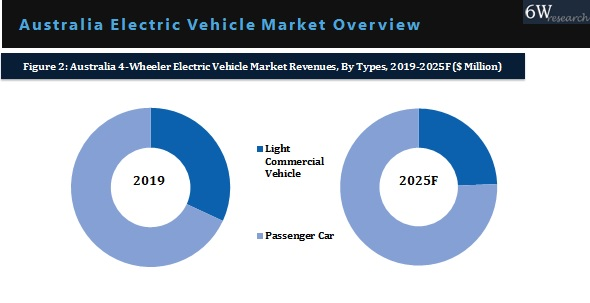Australia 4-Wheeler Electric Vehicle Market (2025-2031) | Outlook, Share, Revenue, Analysis, Size, Value, Growth, Industry, Trends, Companies & Forecast
Market Forecast By Vehicle Types (Passenger Car and Light Commercial Vehicle (Goods Carrier), By Charger Types (AC and DC), By DC Charger Connector Types (CHAdeMO, CCS and Others (including Tesla superchargers and GB/T)), By DC Charger Power Ratings (40-80 kW, 80-120 kW, and 120-200 kW), By End Consumers (Public and Private) And Competitive Landscape.
| Product Code: ETC072145 | Publication Date: Jan 2024 | Updated Date: Jan 2025 | Product Type: Report | |
| Publisher: 6Wresearch | No. of Pages: 70 | No. of Figures: 35 | No. of Tables: 5 | |
Australia 4-Wheeler Electric Vehicle Market Highlights
| Report Name | Australia 4-Wheeler Electric Vehicle Market |
| Forecast period | 2025-2031 |
| CAGR | 11.9% |
| Growing Sector | Transportation |
Topics Covered in the Australia 4-Wheeler Electric Vehicle Market
Australia 4-Wheeler Electric Vehicle Market report thoroughly covers the market by vehicle types, charger types, dc charger connector type, by dc charger connector. The market outlook report provides an unbiased and detailed analysis of the ongoing market trends, opportunities/high growth areas, and market drivers which would help the stakeholders to devise and align their market strategies according to the current and future market dynamics.
Australia 4-Wheeler Electric Vehicle Market Synopsis
Australia 4-Wheeler Electric Vehicle Market is likely to grow as it provides an eco-friendly alternative to fossil fuel vehicles. Australia, being a part of this changing scenario, has seen a growing interest in 4-wheeler electric vehicles. The sales of electric vehicles (EVs) are on the rise in Australia due to increasing concerns about the damage caused by CO2 emissions. Moreover, the Australian government and several big companies in the country are keen on promoting the growth of the electric vehicle industry. With Australia moving towards environmentally friendly practices, electric vehicles provide a viable substitute to fossil-fuel cars while providing all the necessary amenities for normal consumers.
According to 6Wresearch, the Australia 4-Wheeler Electric Vehicle Market size is projected to grow at the CAGR of 11.9% during the forecast period of 2025-2031. The growing concerns around climate change and the reduction of greenhouse gas emissions are driving the growth of EVs in Australia. Furthermore, the lower cost of ownership of an electric car due to cheaper energy costs, faster acceleration, and government subsidies also make EVs an attractive option. Several car manufacturers are investing heavily in electric vehicles and constantly improving their technology to provide more efficient options to consumers. This has led to a more important interest in EVs in Australia, which is expected to continue to grow in the near future. The government's incentives and initiatives have also played a vital role in promoting EVs. In the recent federal budget, the government announced a heavy package towards the expansion of Australia 4-Wheeler Electric Vehicle Industry. Despite the growing interest, EVs in Australia face significant challenges.
One of the primary challenges is the lack of charging infrastructure across the country, which limits their range and access for users. Additionally, the high upfront cost of electric vehicles, compared to traditional petrol vehicles, discourages many consumers from committing to purchase. The limited options of car models available in Australia, compared to other markets, are also a significant challenge for customers looking to buy an EV.
Government policies and schemes introduced in the Australia 4-Wheeler Electric Vehicle Market
The Australian Government has also initiated several measures to promote the growth of the EV market, aiming to realistically achieve the target and increase the market share by 2031. One such measure is the EV subsidy system, which provides financial incentives to consumers who buy an electric or hybrid vehicle. Additionally, the government has launched initiatives such as the National Electric Vehicle Strategy, which aims to increase the uptake of EVs in the country through collaborations with industry stakeholders.
Leading players in the Australia 4-Wheeler Electric Vehicle Market
The electric vehicle market is gradually becoming more competitive, with several key players entering the Australian market. Electric cars from well-established brands such as Tesla, Nissan, and Hyundai are leading the market, while other automakers such as Renault, Jaguar, and BMW, have also made significant strides. Some of the domestic players in the market include Think Mobility, Tritium, ACE EV, and Tomcar. This competitive landscape with the entry of new players is driving innovation and broadening the range of electric vehicles in Australia and this major factor has propelled Australia 4-Wheeler Electric Vehicle Market Growth.
Future Insight of the Australia 4-Wheeler Electric Vehicle Market
The future of the 4-Wheeler Electric Vehicle Market In Australia, with the country's government and several key players actively investing in the industry. As charging infrastructure and EV models continue to increase, and with the government's electric vehicle subsidies, purchasing an electric car may soon become a realistic option for ordinary Australians. Additionally, developments in technology for battery technology and renewable energy sources, such as solar power, are likely to make ownership even more attractive in the future.
Market analysis by Vehicle Type
Passenger Cars are the most common electric vehicle in Australia. The demand for electric passenger cars is expected to grow significantly in the coming years, driven by factors such as increased availability of models, more charging infrastructure, and improved battery technology. Light Commercial Vehicles (Goods Carriers) are also expected to grow in popularity over time, especially as more models become available.
Market analysis By Charger types
AC charging is the most common way to charge an electric vehicle's battery in Australia. Most home charging stations and public charging stations are AC chargers. DC charging, on the other hand, is much faster than AC charging, but it is also more expensive. There are two types of DC chargers, CHAdeMO and CCS, and they are both expected to see significant growth over the next few years. With the rise of electric commercial vehicles, the demand for DC charging is expected to increase significantly in the near future.
Market analysis by By Dc Charger Connector types
The two primary DC connectors in Australia are CHAdeMO and CCS, with other offerings such as Tesla superchargers and GB/T. The CCS socket is more common in Europe, while CHAdeMO has been the primary DC connector in Australia. However, that trend is slowly changing, with more CCS chargers installed in recent years. As a result, CCS is expected to grow more than CHAdeMO, but Tesla and GB/T will play a significant role in their respective segments.
Market analysis By dc charger Power rating
According to Shivankar, Research Manager, 6Wresearch, DC chargers come in three power ratings: 40-80 kW, 80-120 kW, and 120-200 kW. While the 40-80 kW segment currently dominates the market, the higher power ratings are expected to grow faster. Tesla's superchargers, capable of delivering up to 250 kW, have played a significant role in boosting the adoption of higher power rating EVs, and more offerings are expected in this segment.
Market analysis By End -use Consumers
The public charging segment has been growing at a steady pace, with more government-supported initiatives to install charging infrastructure in residential and commercial areas. Private chargers, on the other hand, have become more common in households with EV owners or workplaces with EV fleets. With the growth of electric vehicles, many property developers are retrofitting charging infrastructure in their construction projects, accelerating the growth of private chargers.
Key attractiveness of the report
- 10 Years Market Numbers.
- Historical Data Starting from 2021 to 2024.
- Base Year: 2024.
- Forecast Data until 2031.
- Key Performance Indicators Impacting the Market.
- Major Upcoming Developments and Projects.
Key Highlights of the Report:
- Australia 4-Wheeler Electric Vehicle Market Overview
- Australia 4-Wheeler Electric Vehicle Market Outlook
- Australia 4-Wheeler Electric Vehicle Market Forecast
- Historical Data and ForecastAustralia 4-Wheeler Electric Vehicle MarketRevenues and Volume for the Period 2021-2031F
- Historical Data and Forecast ofAustralia 4-Wheeler Electric Vehicle MarketRevenues and Volume, By Vehicle Types, for the Period 2021-2031F
- Historical Data and Forecast ofAustralia 4-Wheeler Electric Vehicle MarketRevenues and Volume, By Charger Types, for the Period 2021-2031F
- Historical Data and Forecast ofAustralia 4-Wheeler Electric Vehicle MarketRevenues and Volume, By DC Charger Connector Types, for the Period 2021-2031F
- Historical Data and Forecast ofAustralia 4-Wheeler Electric Vehicle MarketRevenues and Volume, By DC Charger Power Ratings, for the Period 2021-2031F
- Historical Data and Forecast ofAustralia 4-Wheeler Electric Vehicle MarketRevenues and Volume, By Charger End Consumers, for the Period 2021-2031F
- Market Drivers and Restraints
- Industry Life Cycle
- Porter’s Five Force Analysis
- Market Trends
- JapanVehicle MarketRevenue Ranking, By Companies
- Competitive Benchmarking
- Company Profiles
- Key Strategic Recommendations
Market Covered
The report offers a comprehensive study of the subsequent market segments:
By Vehicle Types
- Passenger Car
- Light Commercial Vehicle (Goods Carrier)
By Charger Types
- AC
- DC
- By DC Charger Connector Types
- CHAdeMO
- CCS
- Others (including Tesla superchargers and GB/T)
By DC Charger Power Ratings
- 40-80 kW
- 80-120 kW
- 120-200 kW
By Charger End Consumers
- Public
- Private
Australia 4-Wheeler Electric Vehicle Market (2025-2031): FAQs
| 1. Introduction |
| 1.1 Market Scope & Segmentation |
| 1.2 Research Methodology – Sources of Information |
| 1.3 Robust Forecasting Model |
| 1.4 Assumptions |
| 2. Australia 4-Wheeler Electric Vehicle Market Overview |
| 2.1. Australia 4-Wheeler Electric Vehicle Market Overview |
| 2.2. Australia 4-Wheeler Electric Vehicle Market Revenues and Volume, 2021-2031F |
| 2.3. Australia 4-Wheeler Electric Vehicle Market Revenue Share, By Types |
| 2.3.3. Australia 4-Wheeler Electric Vehicle Market Revenue and Volume Share, 2021 & 2031F |
| 2.4. Australia 4-Wheeler Electric Vehicle Market Revenues and Volume, 2021-2031F |
| 2.5. Australia 4-Wheeler Electric Vehicle Market Overview, By Types |
| 3. Australia 4-Wheeler Electric Vehicle Charging Infrastructure Market Overview |
| 3.1. Australia 4-Wheeler Electric Vehicle Charger Market Revenues and Volume, 2021-2031F |
| 3.2. Australia 4-Wheeler Electric Vehicle Charger Market Revenue and Volume Share, By Types, 2021 & 2031F |
| 3.2.1. Australia AC Charger Electric Vehicle Market Revenue and Volume Share, 2021 & 2031F |
| 3.2.2. Australia DC Charger Electric Vehicle Market Revenue and Volume Share, 2021 & 2031F |
| 3.3. Australia 4-Wheeler Electric Vehicle Charger Market Revenues and Volume, By Type 2021-2031F |
| 3.3.1. Australia AC Charger Electric Vehicle Market Revenues and Volume, 2021 & 2031F |
| 3.3.2. Australia DC Charger Electric Vehicle Market Revenues and Volume, 2021 & 2031F |
| 3.4. Australia 4-Wheeler Electric Vehicle Charger Market Volume Share, By End Consumers, 2021 & 2031F |
| 3.4.1. Australia Public End Consumer 4-Wheeler Electric Vehicle Charger Market Volume, 2021-2031F |
| 3.4.1. Australia Private End Consumer 4-Wheeler Electric Vehicle Charger Market Volume, 2021-2031F |
| 3.5. Australia DC Charger Market Volume Share, By Connector Types, 2021 & 2031F |
| 3.5.1. Australia CHAdeMO DC 4-Wheeler Electric Vehicle Charger Market Volume, 2021-2031F |
| 3.5.2. Australia CCS DC 4-Wheeler Electric Vehicle Charger Market Volume, 2021-2031F |
| 3.5.3. Australia Other DC 4-Wheeler Electric Vehicle Charger Market Volume, 2021-2031F |
| 3.6. Australia DC Charger Market Volume Share, By Power Rating, 2021 & 2031F |
| 3.6.1. Australia 40-80 kW DC Electric Vehicle Charger Market Volume, 2021-2031F |
| 3.6.2. Australia 80-120 kW DC Electric Vehicle Charger Market Volume, 2021-2031F |
| 3.6.3. Australia 120-200 kW DC Electric Vehicle Charger Market Volume, 2021-2031F |
| 3.7. Australia 4-Wheeler Electric Vehicle High Power Charger Market Volume, 2022F-2031F |
| 3.8. Australia 4-Wheeler Electric Vehicle Charging Infrastructure - Ecosystem |
| 4. Australia 4-Wheeler Electric Vehicle Charging Infrastructure Competitive Landscape |
| 4.1. Australia 4-Wheeler Electric Vehicle Charger Volume, By Company, 2024 |
| 4.2. Australia 4-Wheeler Electric Vehicle Charger Market Volume Share, By Company, 2024 |
| 5. Company Profiles |
| 6. Disclaimer |
Market Forecast By Vehicle Types (Passenger Car and Light Commercial Vehicle (Goods Carrier), By Charger Types (AC and DC), By DC Charger Connector Types (CHAdeMO, CCS and Others (including Tesla superchargers and GB/T)), By DC Charger Power Ratings (40-80 kW, 80-120 kW, and 120-200 kW), By End Consumers (Public and Private) And Competitive Landscape.
| Product Code: ETC072145 | Publication Date: May 2022 | Product Type: Market Research Report | |
| Publisher: 6Wresearch | No. of Pages: 80 | No. of Figures: 14 | No. of Tables: 8 |
Australia 4-Wheeler Electric Vehicle Market report comprehensively covers the market by vehicle types, charger types, DC charger connector types, DC charger power ratings, and end consumers. Australia 4-Wheeler Electric Vehicle market report provides an unbiased and detailed analysis of the ongoing trends, opportunities/high growth areas, and market drivers which would help the stakeholders to devise and align their market strategies according to the current and future market dynamics.
Australia 4-Wheeler Electric Vehicle Market Synopsis
The incursion of the COVID-19 pandemic has resulted in a slowdown in the Australia economy during the first half of 2020 further obstructing the growth of Australia electric vehicle market. However, Australia 4-wheeler electric vehicle market is expected to witness exponential growth in the forecast period owing to the increase in ultra-rapid and fast chargers in the country.
According to 6Wresearch, Australia 4-wheeler electric vehicle market size grew at a CAGR of 16.2% during 2020-2025. Electric vehicle charging network, Chargefox, received $3 Million from the Victorian government to develop a network of seven ultra-rapid charging stations across regional Victoria which would boost the demand for passenger electric vehicles in the region. In addition to this, the NSW government would support the availability of electric vehicle models by setting a target of 10% for new NSW government general-purpose fleet cars where 10% of new vehicles purchased or leased by agencies be electric or hybrid vehicles.
Market Analysis By Vehicle Types
The light commercial vehicle segment accounts for a low volume share in 4-wheeler electric vehicle market due to presence of fewer available models in the country which is the primary reason behind the low demand for them. Although, in the coming years, the three major commercial vehicle suppliers to Australia – Hino, Fuso, and Isuzu – have indicated their intention to bring more electric models to market which would further lead to an increase in demand for light commercial vehicle in the country.

Key Attractiveness of the Report
- COVID-19 Impact on the Market.
- 6 Years Market Numbers.
- Estimated Data Starting from 2020 to 2025F.
- Base Year: 2019
- Forecast Data until 2025F.
- Key Performance Indicators Impacting the Market.
- Major Upcoming Developments and Projects.
Key Highlights of the Report
- Australia 4-Wheeler Electric Vehicle Market Overview
- Australia 4-Wheeler Electric Vehicle Market Outlook
- Australia 4-Wheeler Electric Vehicle Market Forecast
- Historical Data and Forecast Australia 4-Wheeler Electric Vehicle Market Revenues and Volume for the Period 2019-2025F
- Historical Data and Forecast of Australia 4-Wheeler Electric Vehicle Market Revenues and Volume, By Vehicle Types, for the Period 2019-2025F
- Historical Data and Forecast of Australia 4-Wheeler Electric Vehicle Market Revenues and Volume, By Charger Types, for the Period 2019-2025F
- Historical Data and Forecast of Australia 4-Wheeler Electric Vehicle Market Revenues and Volume, By DC Charger Connector Types, for the Period 2019-2025F
- Historical Data and Forecast of Australia 4-Wheeler Electric Vehicle Market Revenues and Volume, By DC Charger Power Ratings, for the Period 2019-2025F
- Historical Data and Forecast of Australia 4-Wheeler Electric Vehicle Market Revenues and Volume, By Charger End Consumers, for the Period 2019-2025F
- Market Drivers and Restraints
- Industry Life Cycle
- Porter’s Five Force Analysis
- Impact Analysis of COVID-19
- Market Trends
- Japan Vehicle Market Revenue Ranking, By Companies
- Competitive Benchmarking
- Company Profiles
- Key Strategic Recommendations
Market Scope and Segmentation
The report provides a detailed analysis of the following market segments:
By Vehicle Types
- Passenger Car
- Light Commercial Vehicle (Goods Carrier)
By Charger Types
- AC
- DC
By DC Charger Connector Types
- CHAdeMO
- CCS
- Others (including Tesla superchargers and GB/T)
By DC Charger Power Ratings
- 40-80 kW
- 80-120 kW
- 120-200 kW
By Charger End Consumers
- Public
- Private
- Single User License$ 1,995
- Department License$ 2,400
- Site License$ 3,120
- Global License$ 3,795
Search
Related Reports
- Portugal Electronic Document Management Market (2025-2031) | Strategy, Consumer Insights, Analysis, Investment Trends, Opportunities, Growth, Size, Share, Industry, Revenue, Segments, Value, Segmentation, Supply, Forecast, Restraints, Outlook, Competition, Drivers, Trends, Demand, Pricing Analysis, Competitive, Strategic Insights, Companies, Challenges
- France Electronic Document Management Market (2025-2031) | Strategy, Consumer Insights, Analysis, Investment Trends, Opportunities, Growth, Size, Share, Industry, Revenue, Segments, Value, Segmentation, Supply, Forecast, Restraints, Outlook, Competition, Drivers, Trends, Demand, Pricing Analysis, Competitive, Strategic Insights, Companies, Challenges
- Portugal Occupational Health & Safety Services Market (2025-2031) | Strategy, Consumer Insights, Analysis, Investment Trends, Opportunities, Growth, Size, Share, Industry, Revenue, Segments, Value, Segmentation, Supply, Forecast, Restraints, Outlook, Competition, Drivers, Trends, Demand, Pricing Analysis, Competitive, Strategic Insights, Companies, Challenges
- Netherlands Occupational Health and Safety Services Market (2025-2031) | Strategy, Consumer Insights, Analysis, Investment Trends, Opportunities, Growth, Size, Share, Industry, Revenue, Segments, Value, Segmentation, Supply, Forecast, Restraints, Outlook, Competition, Drivers, Trends, Demand, Pricing Analysis, Competitive, Strategic Insights, Companies, Challenges
- Belgium and Luxembourg Facility Management Market (2025-2031) | Strategy, Consumer Insights, Analysis, Investment Trends, Opportunities, Growth, Size, Share, Industry, Revenue, Segments, Value, Segmentation, Supply, Forecast, Restraints, Outlook, Competition, Drivers, Trends, Demand, Pricing Analysis, Competitive, Strategic Insights, Companies, Challenges
- Russia Women Intimate Apparel Market (2025-2031) | Strategy, Consumer Insights, Analysis, Investment Trends, Opportunities, Growth, Size, Share, Industry, Revenue, Segments, Value, Segmentation, Supply, Forecast, Restraints, Outlook, Competition, Drivers, Trends, Demand, Pricing Analysis, Competitive, Strategic Insights, Companies, Challenges
- Africa Chocolate Market (2025-2031) | Size, Share, Trends, Growth, Revenue, Analysis, Forecast, industry & Outlook
- Global Hydroxychloroquine And Chloroquine Market (2025-2031) | Industry, Trends, Size, Outlook, Growth, Value, Companies, Revenue, Analysis, Share, Forecast
- Saudi Arabia Plant Maintenance Market (2025-2031) | Industry, Size, Growth, Revenue, Value, Companies, Forecast, Analysis, Share & Trends
- Taiwan Electric Truck Market (2025-2031) | Outlook, Industry, Revenue, Size, Forecast, Growth, Analysis, Share, Companies, Value & Trends
Industry Events and Analyst Meet
Our Clients
Whitepaper
- Middle East & Africa Commercial Security Market Click here to view more.
- Middle East & Africa Fire Safety Systems & Equipment Market Click here to view more.
- GCC Drone Market Click here to view more.
- Middle East Lighting Fixture Market Click here to view more.
- GCC Physical & Perimeter Security Market Click here to view more.
6WResearch In News
- Doha a strategic location for EV manufacturing hub: IPA Qatar
- Demand for luxury TVs surging in the GCC, says Samsung
- Empowering Growth: The Thriving Journey of Bangladesh’s Cable Industry
- Demand for luxury TVs surging in the GCC, says Samsung
- Video call with a traditional healer? Once unthinkable, it’s now common in South Africa
- Intelligent Buildings To Smooth GCC’s Path To Net Zero













